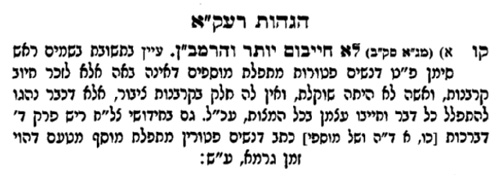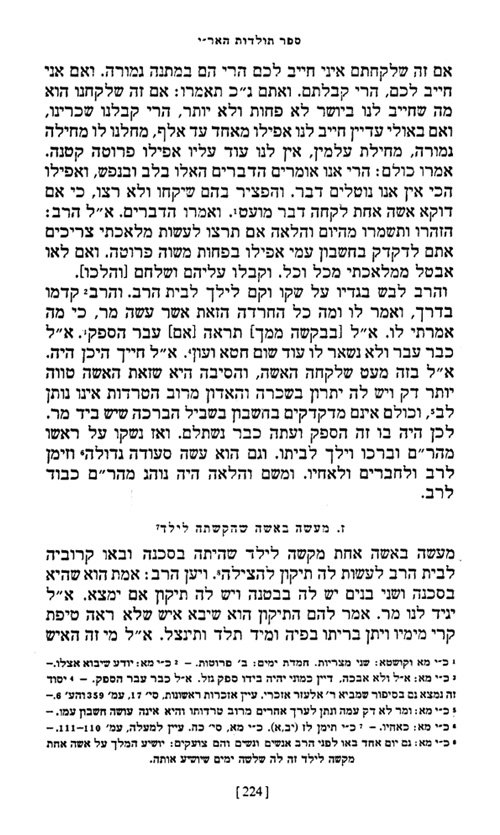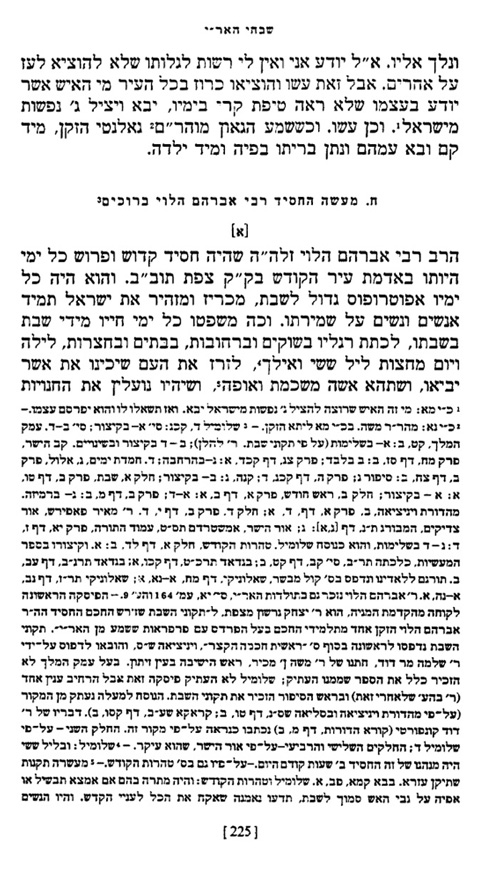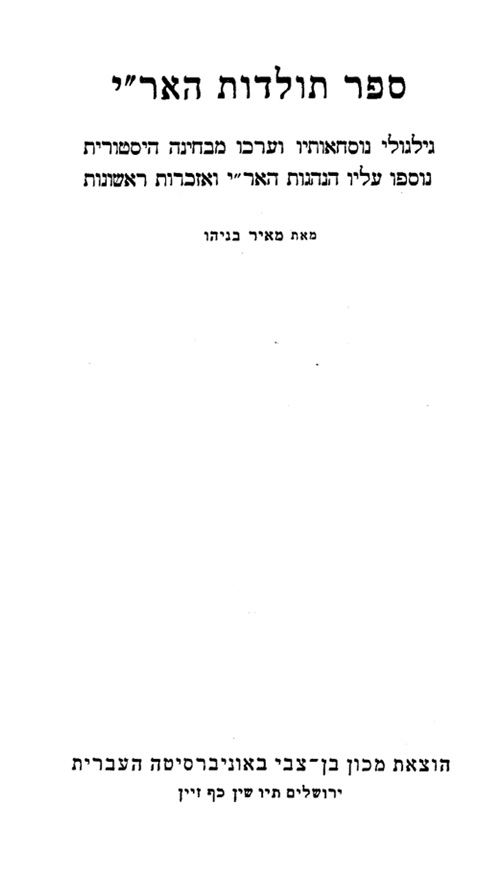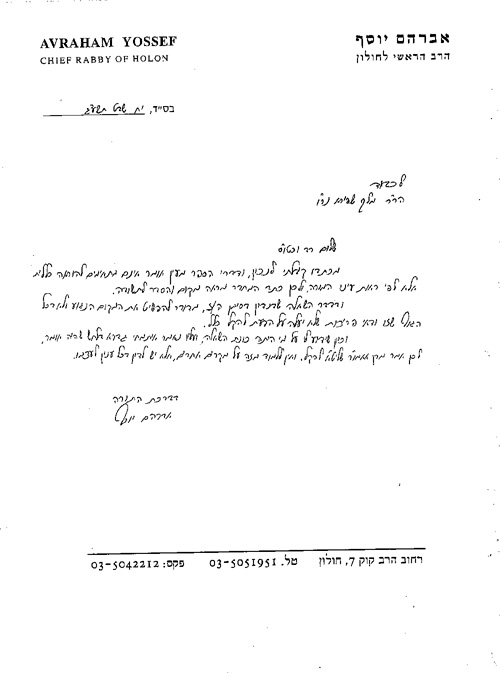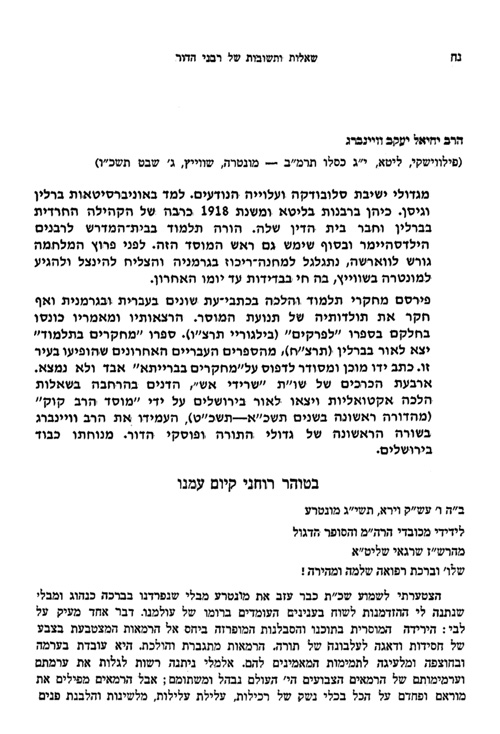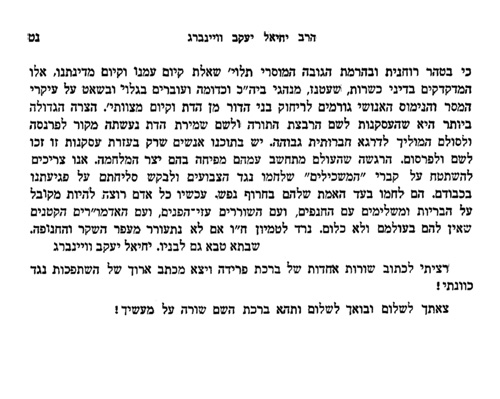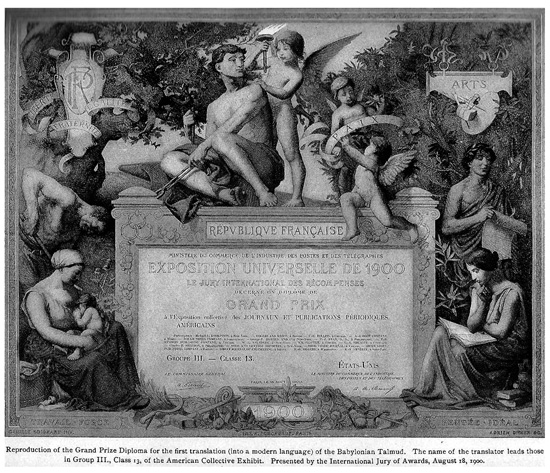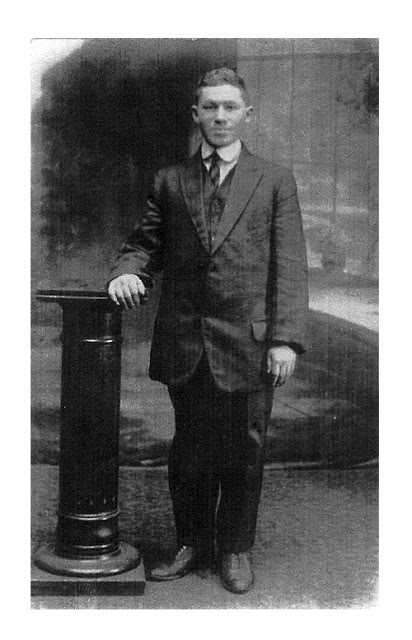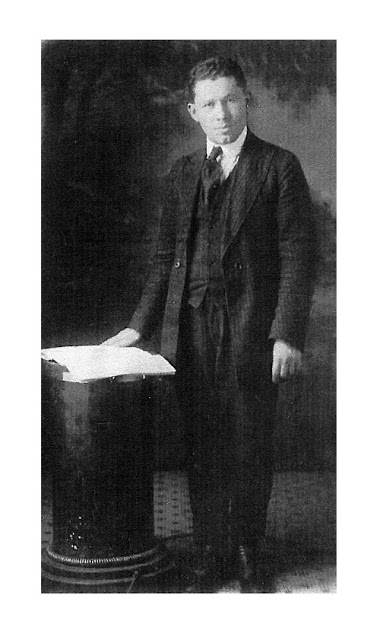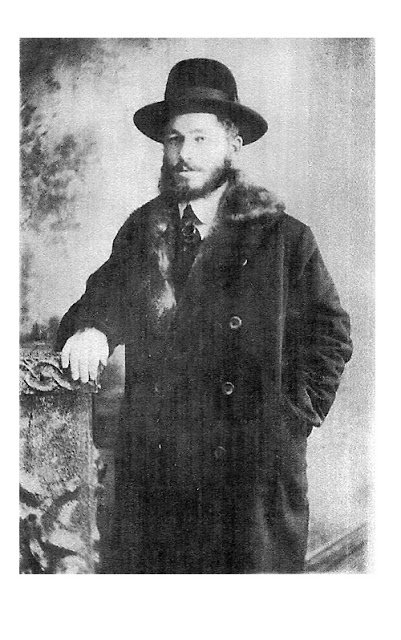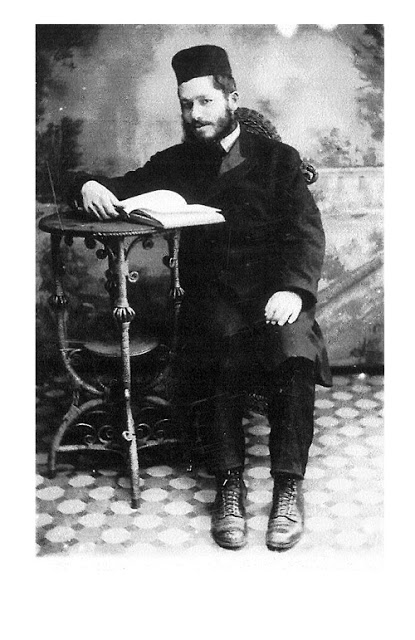Summer of 2013 Book Sale
of 2013 Book Sale
Eliezer Brodt
seforim and books printed by the Iggud. The rest of the list is composed of
seforim and books which I came across while hunting for seforim. Many of these
titles are very hard to find. Some of the prices are better than others, but
all in all I think they are fair. Almost all the books are brand new or in very
good shape. Also included in this list are over one hundred titles of academic
books that are in print but are being offered here for cheaper prices. There is
only one copy of many of these titles so they are being sold on a first
come, first serve basis. E mail your order to eliezerbrodt@gmail.com. I will than send you a bill based on
what is available. Payment will be done Via Pay Pal. Shipping is not included
in the price; that depends on the order and size, ranging between 5-9 dollars (with a few exceptions) a
book. All books will be air mailed out after I receive the money.
for details about any specific book on the list. All questions should be sent
to me at eliezerbrodt@gmail.com thank you and
enjoy.
of
this sale will be going to help support the efforts of the Seforim blog.
למדעי יהדות
שרה
יפת, פירוש ר’ שמואל בן מאיר (רשב”ם) לשיר השירים 20$
שולמית
אליצור, למה צמנו? [מצוין] 20$
צבי
בצר, מנחת שי על חמישה חומשי תורה 20$
שולמית
אליצור, פיוטי רבי פנחס הכהן 20$
חיים
קרייסל, לוית חן לר’ לוי בן אברהם 20$
יאיר
שיפמן, מורה המורה לשם טוב פלקירה 20$
משה
גיל ועזרא פליישר, רבי יהודה הלוי ובני חוגו [מצוין] 20$
אהרן
דותן, אור ראשון בחכמת הלשון שני חלקים 36$
רימון
כשר, תוספתות תרגום לנביאים 20$
שולמית
אליצור, מחזורי שבעתות לסדרים ולפרשות 20$
מהר”ם מרוטנבורג וחבירו ב’ חלקים
מהדיר: שמחה עמנואל 50$
דשמואל זעירא – שמואל אשכנזי חלק א 852 עמודים 52$
רוטשטיין, מידות סדום, ראשי פרקים מקורות והערות, [מצוין] [נדיר] 298+ 532 עמודים,
24$
גולדהבר, קונדיטון, [לשאלת החרם על ספרד, אסון הטיטאניק מנקודת מבטו של העולם
היהודי] 15$
חז”ל-גאונים ראשונים
מגילת תענית [יצחק בן צבי] 25$
מסכת אבות על פי כתבי יד, ב’ חלקים,
כארולוס טילור 32$
מכילתא
דרבי ישמעאל, מהדורת מ’ איש שלום, 15$
איש שלום, 15$
ספרי
דברים, מהדורת פינקלשטיין, 18$
תנא דבי אליהו, מהדורת איש שלום, 18$
13$
ספרי זוטא דברים, מ’ כהנא, מהדיר, 31$
קטן על פי כתב יד ע”י י’ פרייס, 14$
שיירי כתבי יד של בבלי ראש השנה מגניזה בקהיר [מהדיר: ד’ גולינקין], 20$
מן הגניזה 34$ [מהדיר: מרדכי מרגליות]
ישראל, הלכה והיסטוריה, בארץ ישראל [מהדיר: הלל נימן] תשע”א, 23$
מדרשות – ב’ חלקים, ר’ אהרן ורטהימר, 50$
הגאונים: כולל ה’ חיבורים של ר’ בנימין משה לוין: אוצר חילוף מנהגים בין בני ארץ
ישראל ובני בבל ספר מתיבות ספר חפץ לתלמוד רב שרירא גאון , תולדות חיים אגרות
רב שרירא גאון [שני הנוסחות וכו’]: 19$
עפשטיין [חלק א כולל אלדד הדני, חלק ב כולל מקדמוניות היהודים, מוסד רב קוק], 50$
אנשי מזרח ובני ארץ ישראל, [מהדיר: מרדכי מרגליות], 33$
לסדר טהרות, [מהדיר: י”נ אפשטיין], ירושלים תשמ”ב, 25$
שערי צדק שאלוניקי שערי צדק ירושלים 28$
פסוקות, עם תשלום הלכות פסוקות, [נחמן דנציג], 18$
שמואל בן חפני גאון, [מהדיר: יהודה שטמפפר] 19$
לרב האי גאון, [מהדיר שרגא אברמסון], 24$
גינצבורג, 25$
מהדיר: אפרים אורבך, 28$
מסכת פסחים פסח ראשון, 19$
חכמי צרפת מפרשי המקרא מאת אברהם גייגר מאמר על פי’ רש”י למסכות נדרים ומועד
קטן, ב’ צאמבער, 24$
עזרא, יסוד מורא וסוד תורה, [בר אילן] 28$
התורה מכתב יד, הוצאת ליהמן 28$
ילקוט מכירי, ישיעה משלי 16$
התורה, מהדורת דוד ראזין, 15$
מהדיר: א’ קופפר 25$
לרבי מתתיה היצהרי, מהדיר יעקב שפיגל, 15$
מיגאש, כבוד אלקים, מגנס 35$
סמ”ק עם הגהות מהר”י צייטליש 24$
מיוחס לספר שמות 23$
לר’ אביגדור כ”ץ 20$
אלהים, עם מבואות והערות, ברכה גנוט דרור, 24$
הנגיד שמות 22$
טעמי וסודות התפילות להושענות ופיוטי שמחת
תורה להרוקח 8$
ברבי נתן [ש’ חגי מהדיר] 21$
קריאת שמע, תפילה וברכות מוסד רב קוק 30$
אשר בן רבי חיים על הלכות ברכות 13$
ובנו ר’ אברהם, [כולל: תשובות הרמב”ם השלם, ספר חידושי הרמב”ם, אגרות
ואמרי הרמב”ם השלם, חידושי הרמב”ם למסכת ר”ה, ספר ברכת אברהם לר’
אברהם בן הרמב”ם] 18$
פירושי מסכת פסחים וסוכה מבית מדרשו של רש”י, מקיצי נרדמים, ירושלים
תשמ”ד, 11$
תשובות חכמי פרובינציא, מהדיר, ר’ אברהם
סופר, 26$
ר’ יהודה חלאוה, אמרי שפר על התורה 13$
רבי
חסדאי קרשקש, אור השם, מהדורות ר’ שלמה פישר, 24$
בכרך, [בעל ה’חות יאיר’], מר קשישא, ספר כללים [מצוין!] 12$
ואלדבערג, דרכי השינויים, מחקר על דרכי מדרש הכתובים בספר חז”ל, 28$
אמונה והשגחה לב האריה [ר’ יהודה אריה מודינא]צמח צדיק [ר’ יהודה אריה מודינא]
צל העולם מזור ותרופהאלדד הדני, 19$
עמודי ששדעת קדושיםזכר צדיק 20$
דמשק אליעזר, 15$
ממרון הגרי”מ חרל”פ 13$
אור לגויים הלכות עבודה זרה, 18$
פרידמן, שו”ת נצר מטעי 18$
זה השלחן, ג’ חלקים 36$
קמץ המנחה דרשות על התורה, 22$
יוסף שלזינגר [לב העברי, ברית עולם, חברה מחזירי עטרה ליושנה] 33$
שערי תורת בבל [כולל הערות חשובות על סדר הדורות] [מצוין] 50$
שערי תורת ארץ ישראל [על הירושלמי], 50$
דרך טובים, כמה צוואת, מכ”י 22$
פייוולזאהן נצח ישראל [ספר מלא חומר חשוב ומעניין] 21$
צאינה וראינה – מהדורה עברית מבוארת,
ע”י מ’ קוזק כולל הערות ומבוא על הספר, ירושלים תשל”ה, ש”ד עמודים
+ 54 עמודים (מבוא) 17$
ידיו באמונה [מעניין]17$
דיני תשעה באב ביום א ודיני שבת שלפניו תשע”ב, 9$
וזרח השמש, מנהגי מנין ותיקין בבית הכנסת תפארת ציון בבני ברק 14$
ויש לישב במהרש”א] 5$ כריכה רכה
-ספר ויקרא ב’ חלקים 50$
לנפש חיה, הרב לייטר [מצויין] 16$
מהלכות פסח, עם הערות הגאון רי”פ פערלא, 16$
אדר”ת, מוסד רב קוק 70$
יהודה, ר’ יהודה מוסקאטו [פורמוט גדול] 18$
עיני יצחק ביאורים וחידושים בעין יעקב, [כריכה רכה] 15$
אלחריזי, ספר תחכמוני, [זמורה] 16$
גדליה (נדל) [מהדורה שניה] 24$
אביו של ר’ הרצוג, 20$
הוראות והנהגותת שנשמעו מאת רבן של כל בני הגולה ופוסק הדור הגאון ר’ משה
פיינשטיין, תרכא עמודים 19$
חזון איש חלק ג 16$
דמעלי שבתא תיקוני שבת 12$
המהרש”א: חמשה ספרים בכרך אחד: הוראה שעה בית אברהם אמרי בינה מחנה אפרים
ישוב הדעת. 16$
[הלכות הולכי דרכים] [נדפס ב1869] 14$
נוה שלום חלק ב 16$
בארות נתן, ר’ נתן רבינוביץ ביאורים על
הש”ס, 12$.
ר’ יצחק טייב, חקת הפסח, וערך השלחן 18$
מנוחה וקדושה [תלמיד של גר”ח וולאזניר, מצוין] 22$
בעל שם טוב מנוקד, מסודר לפני ענינים, ב’
חלקים 23$
ר’ דוד יואל ווייס, מגדים חדשים, במדבר,
18$
אור פני יצחק, על ר’ יצחק פייגענבוים 13$
ילקוט חדש 8$
מדרש אגדה בראשית עם פ’ עץ יוסף ענף יוסף
ויד יוסף 7$
דרש משה, דרוש ר’ משה ראב”ד קראקא,
15$
מנחת יהודה על ש”ס [תלמיד נחלת דוד]
14$
דרשות ר’ יצחק קארו [מהדירף ש’ רגב], 19$
תורי זהב על שיר השירים שקל הקודש על
מגילת אסתר ברית קודש על עניני מילה לר’ שמואל באנדי 22$
שד”ל על התורה, 22$
גבעת פנחס, ר’ פנחס מפאלאצק, תלמיד
הגר”א 12$.
ר’ יצחק וויס, שיח יצחק על התורה מכון
ירושלים 9$
תורת מוסר ר’ חיים ריינס, מוסד רב קוק, 10$
מאורות נתןברך משה ר’ נתן אלעווסקיא, מכון
ירושלים 9$
משברי ים ר’ משה לייטר, ביאורים וחידושים
לתלמוד בבלי, רעט עמודים, מוסד רב קוק תשל”ט, 13$
ירחון תבונה לר’ ישראל סלנטר 9$
חקר ועיון חלק ג ר’ קלמן כהנא 8$
יצחק קארדווזו, מעלות העברים, [מלא חומר
מעניין] 12$
אמת קנה ספר חסידים [אחיין של
הרא”ש] דרך טוביםדרך סלולה דרך חיים מגילת סדרים [ר’ יהודה הורובייץ
ויכוח ומחקר בין מקובלים ותלמידים] צל המעלות 9$
עזרא מלמד, ב’ חלקים 50$
אונקלוס, 21$
רפאל
פוזן, העקיבות התרגומית בתרגום אונקלוס, [מצוין], 23$
המקרא באור התרגום 20$
אגדות ותולדותיהן 20$
פרקי
דרבי אליעזר, נוסח עריכה ודוגמת סינופסיס של כתבי היד, אליעזר טרייטל, 19$
עיונים
באבות דרבי נתן, נוסח עריכה ופרשנות, מנחם קיסטר, 14$
פרקי מבוא לספרות התלמוד, 38$
עיונים בספרות התלמוד, 32$
מאיר
איילי, פועלים ואומנים, מלאכתם ומעמדם בספרות חז”ל, 33$
ישראל וחכמיה בתקופת המשנה והתלמוד 15$
מגילות 26$
האגדה והמדרש, ב’ חלקים 75$
הסנהדרין, מוסד רב קוק 19$
אורבך, חז”ל פרקי אמונות ודעות [כריכה קשה] 26$
קרוכמאל, [ראבידוביץ] 50$
שרידי הירושלמי, 26$
א, 18$
ב, 30$
ג, [ב’ חלקים] [מצוין] כולל בין השאר חיבור הנפלא ‘תורה שבעל פה פשוטה כמשמעה כוחו
של קוצו של יו”ד’ של יעקב זוסמן 57$
פרנקל 29$
אפשטיין, מבואות לספרות התנאים 50$
אפשטיין, מבואות לספרות האמוראים 50$
וארצות הגולה, ר’ יקותיאל גרינוואלד 50 $
הגדולים, ר’ יקותיאל גרינוואלד 50$
ביכליר 22$
ביכליר 22$
דוד דור ודרשיו, ה’ חלקים 55$
יוסף דרנבורג, משא ארץ ישראל 17$
אברהם ביכלר, עם הארץ הגלילי, מוסד רב קוק
12$
תולדות הישוב היהודי בארץ ישראל ש’ קליין
22$
דניאל שפרבר, תרבות חומרית בארץ ישראל בימי
התלמוד חלק ב 16$
בעקבות תולעת השני הארץ ישראלית, זהר עמר
16$
ר’ דוד צבי הופמן, המשנה הראשונה ופלוגתא
דתנאי 9$
שמואל קרויס, קדמוניות התלמוד, כרך א חלק
א, 15$
ישראל פיינטוך, מסורות ונוסחאות בתלמוד, מחקרים, [בר אילן], 25$
העלייה לרגל בימי בית שני, 33$
ליברמן 28$
תולודת ישראל ב’ חלקים 30$
כחומר ביד היוצר, מעשהי חכמים בספרות חז”ל, 19$
יהודי בבל בתקופת התלמוד [מצוין] 23$
הספרותית של האמוראים, אברהם ווייס $28
הבבלי, אברהם ווייס [נדיר] 30$
מסכת ב”ק 28$
אברהם ווייס 28$
וחכמי דורו, עיונים בסדר הזמנים של אמוראים אחרונים בבל, 28$
תוספתא עתיקתא, מסכת פסח ראשון [מצוין], 25$
הסנהדרין
הגדולה, מוסד רב קוק, הוניג $22
מחורבן לתקומה, 24$
ובירושלמי, א’ שכטר, מוסד רב קוק 26$
בישראל, ר’ יקותיאל גרינוואלד, 20$
התלמודית, [יום עיון לרגל מלאת שמונים שנה לשאול ליברמן], כולל מאמרים מיעקב
זוסמן, ד’ רוזנטל, ש”י פרידמן, ש”ז הבלין ועוד, 24$
מחקרים, מוסד רב קוק 22$
הבלין, מסורת התורה שבעל פה תשע”ב, ניתן לקבל דוגמא 25$ [ספר מצוין, 632
עמודים] 25$
בית שני פ’ חורגין 30$
ההיסטורית, 28$
בנימין דה פריס, מוסד רב קוק $18
ד’ הלבני, סדר נשים 30$
עוברין, סטיבין וולד, 12$
תקופת הסבוראים וספרותה, יעקב אפרתי 23$
ישראל בתקופה המוסלמית הראשונה, ג’ חלקים 85$
הגאונים וספרותה 21$
ספר שעשועים, ליוסף בן מאיר אבן זבארה, 24$
הרכבי, מאסף נדחים, 44$
חדשים גם ישנים 50$
גדולי ישראל, ב’ חלקים 60$
25$
עניינות בספרות הגאונים $40
ובתפוצות, שרגא אברמסון 35$
גויטיין, סדרי חינוך מתקופת הגאונים עד בית הרמב”ם יצחק בן צבי 25$
חכמי אשכנז הראשונים, 28$
מוסד רב קוק 33$
עיונים במשנת הראב”ע, 21$
הלוי, מוסד רב קוק, תש”י, 22$
הרמב”ם מוסד רב קוק, 30$
לרמב”ם טברסקי 32$
מ’ תא-שמע,
הספרות הפרשנית לתלמוד, א, [מצוין] 23$
מ’ תא-שמע,
הספרות הפרשנית לתלמוד, ב, [מצוין] 23$
ואישויותו, בעריכת ד”ר שמעון פדרבוש [אוסף מאמרים] 29$
ויצירתו, תערוכה במלאות 700 שנה לעליתו ארצה ,תשכ”ח, עורך ישראל תא שמע 22
עמודים [כריכה רכה] 13$
שרגא אברמסון 21$
תחנות בספרות ישראל, חלק שני, מזמן ראשית הצמיחה של ספרות ישראל בספרד המוסלימית
עד דורו של ר’ יהודה הלוי, 20$
תחנות בספרות ישראל, ב’ חלקים,
מזמן חתימת התלמוד- מזמן ראשית הצמיחה של ספרות ישראל בספרד המוסלימית עד
דורו של ר’ יהודה הלוי, 40$ [ספרים חשובים]
[אוסף חשוב] 13$
של חסידי אשכנז, איבן מרקוס עורך, 13$
האבן עזרא, ליפשיץ, מוסד רב קוק 20$
מחקרים בדרכו הפרשנית של ר’ אברהם אבן עזרא, אוריאל סימון, [בר אילן] [מצוין], 557
עמודים, 32$
תורה לחכמה, רבי מנחם המאירי ובעלי ההלכה המיימונים בפרובנס, 19$
[אוסף חשוב],14$
להרשב”א דפוס צילום רומא ש”ל עם מבוא של ש’ זלמן הבלין35$,
עיון וחקר, מוסד רב קוק, 20$
הלברטל, 18$
:שמרונת מקוריות מהפכנות, אבי רביצקי עורך, שני חלקים, 32$
י’ ברודי 18$
יצירתו, ב’ חלקים [מצוין] 32$
ופרישות במשנתם של בעלי התוספות, אפרים קנרפוגל 23$
משה איסרליש [רמ”א] מהדורה שניה 42$
החוזה מליטא, 15$
דוד די סילוה הרופא מירושלים, 13$
הורוויץ, רבני פרנקפורט, מוסד רב קוק 34$
ואחרונים, [ספר מצוין] 22$
לבוב וגדוליה, ש’ בובר, [דפוס צילום] 28$
ווילנא], שמואל פין, 70$
מעלות היוחסין מאת ר’ אפרים זלמן מרגליות
עם הערות 10$
חיים [על ווולוז’ין] [ספר מצוין] 33$
קמלהאר, יהושע מונדשיין 19$
פסח פרנק 22$
גרינואלד, הרב ר’ יוהנתן אייבשיץ, 36$
בתמורות הזמן, במשנתו של הרב שלמה זלמן אוירבך, 27$
ותורתו, 18$
(בעל דורות הראשונים), מוסד רב קוק, 22$
לקראת דמוקרטיזציה במנהגיות החרדית דוקטרינת דעת תורה במפנה המאות העשרים והעשרים
ואחת, 16$
קלוגראביר הרועים אהל שלמה 19$
תולדות יצחק 19$
שמעון שלם, מכון בן צבי, [בעריכת מאיר בניהו] 25$
ישראל משה חזן, האיש ומשנתו, 20$
21$
מנדלוביץ 22$
יחיאל פישהאוף, תשס”ב, 419 עמודים, 24$
האדמו”ר מסאטמר, 28$
תולדות שלשת הרועים – ג’ ספרים בכרך אחד:
א]-עטרת הלוים על השל”ה פ’ מדובנא 80 עמודים ב] כתר כהונה על הש”ך- ח’
פרידבערג 37 עמודים ג] שלשלת זהב על ר’ נפתלי כץ 92 עמודים – 23$
50 שנה, היסוטריה הגות רייאליה, קובץ מחקרים תשע”ב, על ר’ צבי פסח פרנק,
כרכיה רכה 23$
גם ישנים, בנתיבי משנתו ההלכתית הגותית של הרב קוק, [מצוין], 20$
אם למסדורת, בר אילן תשל”א, 280 עמודים, [כולל מאמרים על רבו ר‘ איזה’לה מפוניבז’ רב סעדיה גאון ועוד דברים חשובים], 23$
צבי הלוי הורוויץ תולדות משפחת הורוויץ תולדות ר’ איזיקל האמבוגר ברכת יצחק- על
ר’ יצחק הורוויץ, 22$
ומפגשה עם המודרנה 1815-1867, [מציון], 26$
הגאון מווילנה, 19$
[מ’ חלמיש ועוד עורכים], 22$
ביקורת מבוקרת, אלטרנטיבות אורתודוקסיות למדע היהדות 1873-1956, 415 עומדים
[מצוין] [כולל בין השאר, פרקים על בית מדרש של ר’ עזריאל הילדסהיימר, דורות
הראשונים, ר’ דוד צבי הופמן זאב יעבץ, ר’ בנימין משה לוין בעל האוצר הגאונים ועוד[ 24$
שמח הלכה ומשפט, משנתו של הרב הרב מאיר שמחה הכהן על משנה תורה להרמב”ם,
אוניברסיטת בן גורין, 408 עמודים [חשוב], 24$
תפילת העמידה של ימות החול, נוסחי הסידורים בגניזה הקהירית שורשיהם ותולדותיהם,
יצחק בן צבי, 388 עמודים [חדש] [מצוין]. 29$
התגבשות נוסח התפילה במזרח ובמערב, ב’ חלקים, [מצוין] 25$
יוסף היינימן, עיוני
תפילה [כריכה רכה] 24$
יום כיפור 55$
בתפילה בהלכה ובמנהג, 30$
עץ חיים, ר’ יצחק רצהבי, 19$
הגדה של פסח, ר’ מנחם כשר, 20$
מחזור בית דין, לראש השנה, ר’ אברהם חמוי 19$
מחזור דק”ק איטאלייאני, חלק ב, שד”ל,
16$
פליישר, תפילות הקבע בישראל, בהתהותן ובהתגבשותן, ב’ חלקים, 1440 עמודים, 45$
מ’ תא-שמע, התפילה האשכנזית הקדומה, פרקים באופייה ובתולדותיה, 23$
משה חלמיש, חקרי קבלה
ותפילה, 458 עמודים [מלא חומר חשוב[, 24$
כנסת עזרא ספר היובל לכבוד עזרא פליישר, 28$
בתקופת התנאים והאמוראים, יוסף היינימן כרכיה קשה 28$
סידור עבודת הלבבות ספר מקור הברכות, 23$
ישראל, ומוסר היהודות 21$
תפילה ובית הכנסת] [בר אילן] חלק א, 26$
ובית הכנסת] [בר אילן] חלק ב, 19$
ובית הכנסת] [בר אילן] חלק ג, 19$
תפילה ובית הכנסת] [בר אילן] חלק ד, 20$
מחקרי תפילה ופיוט, 18$
מאמרים על תפילה מתרביץ] [מצוין],24$
תאמרנה, השפה הלא מילולית של התפילה, 21$
פיוטי ייני, שני חלקים, 36$
ביאורים ופירושים כרך משלים, נחום ברונזניק 22$
ביאורים ופירושים, נחום ברונזניק 22$
השלם, משה צבי סגל
לקסיקון הכנויים לבשון הפייטנים, 21$
זרחיה הלוי, בעל המאור, 25$
והשירה ב’ חלקים 55$
ישראל זמורה 24$
שמעיה, יונה דוד, 26$
קליר, קדושתאות ליום מתן תורה, ש’ אליצור מהדיר, $24
ר’ אליהו הזקן 17$
יוסף קאפח, 21$
בימי הביניים [מצוין] 28$
נתיבי עם, מנהגים והלכות, 24$
הפולקלור היהודי, 16$
חלק ב 25$
חלק ד 25$
מועדי ישראל בתקופת המשנה והתלמוד, [מצוין] 25$
[כולל הרבה מחקרים חשובים כמו: מסכת אבות פירושיה ותרגומיה, סדר קבלת שבת ופזמון
לכד דודי מגילת אסתר בצפת במאה הט”ז ועוד] 28$
הלכה [אפשר לקבל תוכן הענינים], 15$
את האמצעים 25$
שבייה ופדות, בחברה היהודית בארצות הים התיכון, 18$
בספרות הרבנות ר’ יקותיאל גרינוואלד 25$
ביבליוגרפיה רב לשונית למשפט העברי, 55 $
לאה, ירושלים תשנ”ט, 1000+ עמודים, כולל חיבור חשוב של ר’ דוד צבי
רוטשטיין בשם ‘ספר תורה מנוקד’, יותר מ200 עמודים, על עניני נקודות ועוד, 24$.
מ’ תא-שמע,
מנהג אשכנז הקדמון, 22$
הרמב”ם לסיפור בריאת העולם 20$
הרמב”ם לסיפורים על אדם בפרשות בראשית, 20$
דרכי המחשבה ההלכתית של הרמב”ם, 42$
בספרות העברית, מוסד רב קוק 22$
26$
מן השמים באספקלריה של הדורות, ב’ חלקים 75$
24$
כתבי ר’ יצחק אבן לטיף חלק ב, פירוש קהל
צורת העולם 14$
ר’ יצחק עראמה ומשנתו 22$
מחקרים, מוסד רב קוק 22$
הפילוסופית של ר’ אברהם אבן עזרא 28$
שיחות על אהבה, 45$
עזר הדת, ר’ יצחק פולקר, 16$
מהדיר: מרדכי מרגליות, 60$
תולדות האר”י 115$
ספר חזיונות, ר’ חיים ויטל, מכון בן צבי,
20$
יעקב עמדין [תשנ”ה] 40$
מודניה, ארי נואם, 50$
מודינה, בחינת הקבלה, 50$
ירושלים במחשבת ישראל כרך י, 457 עמודים, [אוסף חשוב], 25$
קיצור סדר האצילות, כתיבת ר’ חיים ויטל,
העתקת ר’ מנחם די לונזאנו, יוסף אביב”י מהדיר, 21$
למגיד ר’ דב בער ממזרידטש, מהדיר רבקה ש”ץ-אופנהיימר, 30$
חלקים, מוסד רב קוק, גדליה נגאל, 45$
והשכלה 27$
ושלוחתיה, ג’ חלקים [מצוין], 52$
ובתולדות הדתות מוגשים לגרשום שלום, 45$
מרכז דינור 22$
הדתות מוגשים לגרשום שלום, 45$
רוחות ונשמות, מחקרים בדמונולוגיה, 19$
הרקיע, פרקים בהתקבלות הזוהר, 21$
כתבי גרשום שלום, 15$
קוק 28$
טמרין חלק ב, מוסד רב קוק 27$
מהדורות רובינשטטין, 22$
בקבלה נבואית 19$
החסידות, 32$
התנועה השבתאית ושלוחותיה, משיחיות שבתאות ופראנקיזם, ב’ חלקים 50$
שמואל ורסס, מגמות וצורות בספרות ההשכלה
20$
ישן מפני חדש שי’ לע’ אטקס, שני חלקים 28$
ד’ אסף, נאחז בסבך, פרקי משבר
ומבוכה בתולדות החסידות 23$
ספר חסידים חיבור גנוז בגנותה של החסידות 18$
צדיק ועדה, ד’ אסף עורך 23$
צייטלין (כריכה קשה) 20$
עולמות ה’ צייטלין (כריכה קשה) 20$
תולדות החסידות, [מצב מצוין], 30$
ונפגע, 32$
השכלה ושבתאות תולדותיו של מאבק 19$
ש’ פיינר 28$
מתירנות וספקנות ביהדות המאה 18, ש’ פיינר 28$
התנועה הפראנקית, 45$
חסידי אשכנז, 25$
ואגרות, 32$
המיסטית אצל אברהם אבולעפיה, שוקן, 18$
תשבי (כריכה רכה)23$
תעלומת ספר [על חמדת ימים] 28$
אופנהיימר, הרעיון המשיחי מאז גירוש ספרד, 21$
התנועות המשיחיות בישראל, 26$
גרשם שלום על האיש ופועלו, דברים שנאמרו
ביום השלושים להסתלקותו [חוברת] 13
ע’ אטקס, בעל השם הבעל שם טוב מאגיה
מיסטיקה הנהגה, 23$
ע’ אטקס, בעל התניא, ר’ שניאור זלמן מלאדי
וראשיתה של חסידו חב”ד 25$
גליקל זיכרונות 1719-1691 חוה
טורניאנסקי, [מצוין] 28$
ד’ אסף, דרך המלכות ר’ ישראל מרוזי’ין 27$
הבעש”ט, מחדש החסידות, משה רוסמן, 18$
18$
(יומן) מהדיר: משה שולוואס 25$
לוצאטו, ביקורתיות מתונה בפירוש המקרא [תשע”ג] [מצוין], 530 עמודים, 32$
הביאור לתורה של מנדלסון, 21$
החסידות וההשכלה, 24$
פיניליש, דרכה של תורה 30$
שני חלקים, 32$
שי”ר, ב’ חלקים 70$
קצוצת מאמרים, מהדורות ש’ פאזנאנסקי, 32$
מעידן ההשכלה הפרשנות, מחקר בשירי תפארת לנפתלי הרץ ויזל, 18$
והגות,21$ [אוסף חשוב של מאמרים]
תנועת ההשכלה היהודית במזרח אירופה, עורך ע’ אטקס, מרכז זלמן שזר 24$
השחר, השכלה היהודית באימפריה הרוסית במאה התשע עשרה, 22$
הקיצה עמי, ספרות ההשכלה בעידן המודרניציה, [אוסף חשוב] 24$
ש’ פיינר ועוד עורכים, 19$
ספר המצרף, ביאורים והגהות לאגדות
חז”ל, אברהם דובזויץ, (דפוס צילום, אודעסא תרל”ו) 15$
בישראל, [מרכז זלמן שזר] עם מבוא של ע’ אטקס 23$
דינור 20$
ירושלים הבנויה 18$
עת לחכמת ישראל, בעריכת נפתלי קלר ומאיר איש שלום, משנת 1864-1866, 66$
מוסד רב קוק 35$
מחקרים בספרות השו”ת, מוסד רב קוק [מצוין] 35$
שו”ת כמקור היסטורי, [מצוין] 17$
ווינער,[אוסף של אריה ליב פרידלאנדר], קהלת משה, ב’ חלקים 125$
אמרים וסיפורים על ספרים 16$
אברהם הברמן 26$
47$
ספרי ברוך שטרויס, אהל ברוך 36$
מסכות סופרים וספרות, תולדות סופרים וחוקרים דברי ביקורת מאמרים ורשימות, 24$
סופרים וספרים [גאונים, ראשונים ותשובות] 28$
העברית בדורות האחרונים, שני חלקים 60$
המחזה העברי, המקורי והמתורגם מראשיתו ועד היום, ביבליוגרפיה, 28$
המדפיס קורניילייו אדיל קינד ובנו דניאל, 17$
מפרי העט והעת, קובץ מאמרים ורשימות בשדה הספרות והתברות 21$
ספרים משה סלוחובסקי יוסף קפלן עורכים, 16$
חדשים גם ישנים, חיבורים שונים מתוך כתבי יד בצירוף מבואות והערות 24$
וספר, עיונים בתולדות הכתב העברי, לשון, כ”י עבריים מצויירים, מקובלים וקבלה,
פולקלור, 24$
אנשים ספר ואנשי מעשה, סופרים חוקרים ביבליוגרפים מדפיסים ומוכרי ספרים, 23$
קבוצי יחד מאמרים ורשימות חלקר ספרות ישראל ותרבותו, 22$
בתולדות המדפיסים העברים, ראשונים ואחרונים 24$
הקהירית בז’נבה, קטלוג ומחקרים, 25$
מגנזי ישראל בוואטיקאן, מוסד רב קוק 33$
printing in America 1735-1926, a History and Annotated Bibliography, 2
volumes, $175
וזכרון
אליהו זוטא אליהו קפשאלי, שני חלקים, 60$
יעקב, מוסד רב קוק [ספר מצוין], 21$
תולדות הפוסקים [פורמט קטן], 19$
ומסות בתולדות עם ישראל, ב’ חלקים 50$
לפוזננסקי, החלק העברי, 26$
גויטיין, סדרי חינוך מתקופת הגאונים עד בית הרמב”ם יצחק בן צבי 25$
בתולודת היהודים בארץ ישראל בארצות המזרח מוסד רב קוק 21$
בתולודת היהודים בארץ ישראל ובאיטליה 21$
מתולדות הרבנות בגרמניה במאה הט”ז, 18$
100$
כורחם: משוגעים ומצורעים בחברה היהודת באירופה בימי הבניים, אפרים שהם שטיינר 23$
אברהם זלמן פריידוס, 36$
ויהדות במזרח אירופה, 22$
ראשונים ועד לימות החורבן, חלק א 20$
ששון, הגות והנהגה, 20$
מחקרים מוגשים לפ’ חיים ביינארט 21$
ומחקרים, 32$
פרידמן ז”ל 23$
הרב סולובייצ’יק, מוסד רב קוק, שני חלקים 120$
ש’ מרסקי 23$
גפני וא’ רביצקי עורכים 15$
גרוסמן, 23$
אברהם הברמן, 25$
זכרון לר’ ראובן מרגליות) 28$
המערב, תולדות ישראל במארוקו, 18$
היהודים במצרים, [בן צבי] 25$
היהודים בממלכת הצלבנים 24$
בארץ ישראל 22$
בארץ ישראל במאה הט”ז, [חומר חשוב] 23$
של הגר”א מקורותיה והשפעתה לדורות, 25$
:תולדותיהם ופעולתם, א’ אלמאליח 24$
ר’ שלמה הכהן אהרנסון 11$
יערי 29$
לראי”ה, מהדורה ראשונה עם הצילומים
של המכתבים, 22$
קורות העתים, מוסד רב קוק, מקורות ארץ ישראל 23$
רב קוק- מקורות ארץ ישראל 19$
שי, (נדיר), 36$
מרדכי ברויאר, 26$
לשון, 25$
מוגשים ליהושע בלאו, 28$
הלשון והרקע הלשוני של מגילת ישעיהו השלמה ממגילות ים המלח, 25$
מחקרים בעברית ובארמית 60$
התרגום לנביאים ראשונים 25$
דקדוק
ארמית, יעקב נחום אפשטין 18$
שערי זמרה הארוך 14$
בן קוריש, תל אביב תשי”ב 17$
עמודים בתולדות הספר העברי, הגהות ומגיהים, [מצוין] 32$
הסימנים השלם, 28$
השיבה אל המסורת, 24$
זכרונות 22$
מוסד רב קוק 18$
חסידות ומורדות, [מצוין], 23$
והוא ימשול בך, האישה במשנתם של חכמי ישראל בימי הביניים, 28$
מדרשות ע’ אטקס עורך, 23$
הליטאית בהתהוותה, [מצוין] 23$
פרקי זכרונות [מצוין], 23$
כרמי שומרון, 22$
האשה באספקלריה היהדות, ג’ חלקים 40$
גיבורות בישראל, 21$
דורות בישראל 18$
ירושלמיות, וברייתא דשמואל הקטן 18$
הדרשה בישראל, 28$
עמנואל 17$ על השואה [יש לציין שר’ שלמה זלמן אורבעך היה קורא בחיבור זה
בתשעה באב]
מחקרי לשון וספרות, חלק א, 22$
מחקרי לשון וספרות, חלק ב, 22$
לשון וספרות, חלק ד, 22$
מחקרי לשון וספרות, חלק ה, 22$
נחמיה
אלוני, מחקרי לשון וספרות, חלק ו, 22$
ר’
אליעזר ליפמן פרינץ, פרנס לדורות, 24$
לפלגת
ישראל באונגריה, ר’ יקותיאל
גרינוואלד 60$ דפוס נדיר
למסכת שבת ר’ אברהם גולדברג 20$
בין
סמכות לאוטונומיה במסורת ישראל, עורכים זאב ספראי, ואבי שגי 23$
משה
סמט, משה מונטיפיורי האיש והאגדה 19$
יוסף
דן, הסיפור העברי בימי הביניים, 19$
ש’
קוק עיונים ומחקרים שני חלקים, מוסד רב קוק, 45$
ש’
קוק, עיונים ומחקרים, מוסד רב קוק חלק א
23$
משל
הקדמוני ישראל זמורה 24$
רפאל
ויס התרגום הארמי לספר איוב 25$
יעקב
לייב שפירא משפחות עתיקות בישראל 32$
ההרים, חיים בלוך עם חתימת המחבר 26$
אבולציה יהודות 22$
קורמאן, יהודי מיהו יהודי 22$
זרמים וכתות ביהדות 22$
מחקרים בספרות השו”ת, מוסד רב קוק [מצוין] 35$
ישראל, וונריב 23$
מוטלה, [דוד אסף עורך], יומן 14$
ובנו ר’ אברהם, זכרונות אב ובנו, [יומן מעניין] מוסד רב קוק $24
אבני חן, שלמה אשכנזי, 20$
קתרסיס, כרך יח תשע”ג, כולל מאמר
ביקורת של פר’ שלמה זלמן הבלין על הספר ‘החזן איש’ של בנימן בראון 16$
החברה קדישה דג”ח וורמיישא, תע”ו-תקצ”ז, א’ אונא, מוסד רב קוק
תש”ם, 204 עמודים 12$.
בן ציון אלפס, מעשה אלפס, ישראל
תשל”ח, רכ עמודים, 8$
ש”י עולומת, דן סדן 9$
M. Heidenheim, Bibliotheca Samaritana
$70
Saadyana Geniza fragments of R. Saadya Gaon 24$
Leo Jung, Men of the Spirit, $23
Kabbalah Gershom
Sholom $10
Dr. Frensdorff, The Messorah Magna,
Ktav press $90$
Paul Kahle, Masoreten Des Ostens $35
Moses Gaster, Studies and
texts 3 vol, Ktav Press $150
Jacob Mann, Collected writings, 3 volumes $150
Jacob Mann Text and studies Volume
one [2 vol], $85
B. Schreiber Zecor Yemos Olam
[customs etc.] $15
A. David, In Zion and Jerusalem, The
Itinerary of Rabbi Moses Basola (1521-1523), $23
Sefer hanisyonot attributed to the Ibn
Ezra, [ Marcus and Leibowitz ed], $45
Jacob Mann, The Jews in Egypt [2
vol. in one] Ktav Press $65
Jacob Mann, Bible as read and preached
in the old Synagogue, {Ktav Press}, 2 volumes, 75$
to survive– $18
of the Babylonian Talmud
Targum to Job From Qumran cave XI Bar Ilan Press, $23


